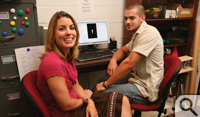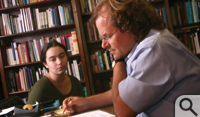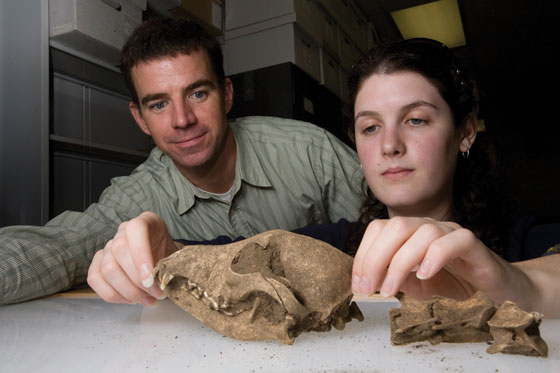Inaugural class of Dintersmith Fellows
New program gives five seniors an intensive faculty-mentored research experience
Five seniors at William and Mary have a head start on their honors projects, after spending the summer doing funded, faculty-mentored research as participants in the College's first class of Dintersmith Fellows.
The program, made possible by Ted Dintersmith '74, is designed to support undergraduate honors research, especially pre-honors research conducted in the summer before the students' senior year. Joel Schwartz, director of William and Mary's Roy R. Charles Center, explains that the primary goals of the Dintersmith Fellowship Program are to provide undergraduates with the support necessary to do high quality research, and to increase the number of students who participate in the senior honors program.
Currently about 10 percent of each class of William and Mary seniors, about 130 students, do an honors program—an in-depth investigation on an approved topic, culminating in a written thesis and an oral defense that is administered by a faculty panel. Most senior honors projects are comparable to graduate school work in terms of scope and rigor.
"Our goal is to attract as many of our strongest students as possible to do honors," he said. "Currently we are funding five students; our goal down the road is to increase this to 20 students."
Dintersmith fellows commit to a 10-week summer research experience. They and their faculty mentors then continue the work begun during the summer throughout the senior year, ending with a senior honors thesis. The Dintersmith Fellows Program provides a modest research stipend for the faculty mentors, as well as providing substantial funding for the students.
"Our senior honors program is built on close student-faculty collaboration and a dedication to integrating the teaching and research missions of the College," Schwarz said. "By providing research funding for both students and their faculty mentors, the Dintersmith Fellows program provides incentives for participation in activity that embodies the essence of our values as an institution."
Native Dog Burials and Associated Ritual in Coastal Virginia
Jennifer Fitzgerald with Martin Gallivan, associate professor of anthropology
Almost no scholarship has been done on the ritual burial of dogs by ancient Algonquin communities of the Virginia coastal plain, so Jennifer Fitzgerald has the field almost to herself. She is working with archaeologist Martin Gallivan to investigate ritual dog graves at four Late Woodland sites along the Chickahominy River.
"Dogs were the only domesticated animals on the East Coast and the Jamestown settlers recorded that they were used as hunting companions but not kept as pets," Fitzgerald explained. "But the rituals of dog sacrifice in neighboring groups and the fact that dogs were the only animals to be buried suggests that they had a significant role in Algonquian communities."
Archaeological examination of the sites has revealed complete skeletons of dogs buried carefully, often in unusual contexts—under an item of grave goods, such as a pot. There are at least two instances at Weyanoke Old Town in which a dog was found buried with a human arm.
"It seems as if dogs are associated with human deaths, because they seem to appear close to human burials in large part," she said. "So I am thinking that they are considered separate from other types of animals and the natives are treating dogs differently because they see them more as this connection with the next life."
The artifacts Fitzgerald is working with were excavated in the 1960s and 1970s by Norman Barka, a William and Mary anthropology professor who died recently. She will use some of the money she received as a Dintersmith fellow to pay for carbon dating of some of the canine remains.
"Jen's really developed the research topic, the research interest, the research project, the schedule, the methods and begun to move toward a bit of interpretation, with some guidance—but largely on her own," Gallivan said. "This is really Jen's research and she has taken the ball and run with it."
Romanticism in China: The Intersection of East and West
Shannon Reed with Xiaobin Jian, associate professor of modern languages and literatures
Shannon Reed and her professor traveled half-way across the world this summer where they have access to periodicals, books and articles that are nearly impossible to obtain in the United States.
When Reed isn't reading the works of Chinese Romantics (in original Chinese) she is translating books on comparative literature and meeting with experts on Chinese and Western literature. Specifically, she is researching the literary genre known as 'Chinese Romanticism' and comparing that with the English Romantic movement of the early 19th century.
"Most of my time goes to translation work," Reed said. "I'm currently translating Professor Sun's book on comparative literature, which besides being a great introduction to comparative literary theory and practice, is also improving my Chinese reading skills."
Her mentor, Xiaobin Jian, says, "By working closely with a leading Chinese scholar in the field and by getting involved in some of his ongoing research projects, Shannon is learning the Chinese perspectives first hand and approaching the 'Chinese mind' closer than many researchers have been able to."
Jian continues, "The significance of Shannon's project lies in the fact that she is attempting to look at the issues from inside out. While most English written studies on China are done from non-Chinese perspectives, Shannon asks questions such as what do the Chinese people think of the issues and why do they see things in such ways?"
Reed adds, "It would be hard to undertake a project on comparative literature without guidance from experts in both Chinese and Western literature, so I consider this summer's research to be indispensable to my thesis research."
"This is particularly impressive for someone who less than three years ago did not even know a single Chinese word!" says Jian.
The Effect of Emotion on Human Motion Perception
Dillon Niederhut with Jeanine Stefanucci, assistant professor of psychology
A few dots of light on a dark computer screen may look, at first, like nothing more than a constellation. But when those lights are put into motion, the seemingly random conglomeration becomes suddenly recognizable as a human walking, running or even imitating a Michael Jackson dance move. Dillon Niederhut is using how people react to these "point-light displays" to research not only what people perceive but how their emotions and body state might affect that perception.
"We call this the 'embodied' theory of perception, which is part of the embodied theory of the brain," he said. "The embodied theory of the brain basically states that what the mind does depends on how the body feels. This produces interesting consequences in perception."
Niederhut has been exploring those consequences with the help of Jeanine Stefanucci. Perception of distances can vary, based on factors including a person's age or physiological capabilities and the emotional state he or she is in. Niederhut is now looking into how emotional state can similarly affect biological motion.
"What Dillon wants to know is, like everything else in our lab, does the emotion of the observer change their perception of the biological motion in the scene," said Stefanucci.
Niederhut will induce emotion in his participants and then ask them to observe point-light displays. He will then ask them to make some sort of judgment about the motion that is being performed, examining how quickly participants respond and what they might say about the display.
"While distance and motion perception is very basic--even frogs see motion--biological motion processing is a higher order function. So, we have the potential for some interesting findings here," said Niederhut. "If emotion produces any effect at all, we can show empirically that it can change higher order processing."
Synthesis and Analysis of Photochromic Dithienylethenes
Brooklynd Saar with Elizabeth Harbron, associate professor of chemistry

Brooklynd Saar is trying to find a use for one of the photochromic molecules known as dithienylethenes—but before she can study the molecule she has to make some of it in the lab.
"Other people have made this compound, but you can't buy it," explains Saar's mentor, Elizabeth Harbron. "Everyone has to make their own. It's not commercially available, but once she has made it, maybe we can transform it into things that no one's made before."
There is a wide array of photochromic molecules, light-sensitive chemicals that change color and/or fluorescence upon exposure to light . Dithienylethenes are a class that show particularly promising photochromic properties, in that an adroit chemist can use light to toggle the molecule between colors or degree of fluorescence. Such molecules are used in biologic studies and have potential applications for cell phones, laptop screens and other electronic displays.
Synthesis of Saar's target molecule is a challenge in itself, and she hopes to have enough of her dithienylethene made by the end of the summer to begin analysis. She ran across some bumps in the road, mainly in the form of contamination in the synthesis process. Harbron explained that Saar is following an established, multi-step procedure to make her molecule.
"What she's trying to do in each of these steps is to add one atom," Harbron said. And not just add one atom, but add it in a very specific place." Saar is getting her target molecule as a main product, but the sample also contains unwanted byproducts.
Saar has started over again, using a different, less-reactive process and feels confident about the outcome.
"I think we've ironed out the problems," she said. "We're pretty confident that we're going to be done with the synthesis probably by the end of the summer. And then we can start working on the fun analysis part."
"Truly Though Not Ostentatiously:" Wordsworth and the Odic Tradition
Lindsay Gibson with Professor Adam Potkay

Lindsay Gibson will be completing her honors thesis focusing on the Romantic poet William Wordsworth's odes (written 1798-1834) in a poetic tradition that stretches back to Pindar in Greek and Horace in Latin.
"My project emerged largely from a wish to combine some of my Classics background with a thesis in English literature," Gibson explained. "I had studied Horace extensively in high school. At William and Mary, Professor Potkay was responsible for exposing me to Wordsworth's major odes in my freshman English survey course."
Potkay says Gibson has embarked upon an important scholarly project, embracing not only Wordsworth, but also the original works that inspired him.
"Lindsay has a firm command of the difficult Greek and Latin originals--and their earlier English imitations and extension--against which Wordsworth would have us understand and judge his achievement," Potkay said. "There is a substantial body of secondary literature on the history of the ode form from antiquity onwards--Lindsay has already taken the first steps towards mastering this--but little of it treats Wordsworth's place in this history with any detail."
Gibson's project deals with much of the history of English and Greek literature as well as Greek, Roman and Hebrew poetry. She said some consider Wordsworth's works "dry" or a bit "stodgy" in comparison to his contemporaries and to later Romantic poets. So Gibson has decided to use odes as a lens for her analysis, to reassess Wordsworth's "revolutionary" impact on English poetry over the span of a long and prolific career.
Gibson hopes to trace the development of the ode in Classical and English literature, and to examine the ways in which Wordsworth draws on these earlier traditions. "Also, I would like to assess what he contributes to the form in later Romantic poets, particularly Keats and Shelley," she says.
"I hope to be able to read at least some of the Classical sources in their original languages, and I believe that my background in Classics will greatly enrich my analysis of this subject."

















